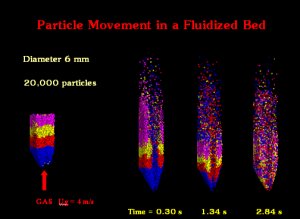โปรแกรมการจำลองการเคลื่อนที่เม็ดอนุภาคในระบบชองแข็ง-ก๊าซ
Simulation Program for Particle Movement
in Solid-Gas Systems
ดร. สุนันท์
ลิ้มตระกูล
ABSTRACT
Gas-solid
systems such as pneumatic conveying and
fluidized bed play important roles in
industrial processes. Although, the solids
flow pattern in gas-solid systems is necessary
for the design and operation, it is difficult
to access due to the complex interaction
of the particles in the system. The two-fluid
model, which regards the solids particles
as a continuum was usually used to simulate
the flow behavior in gas-solid systems.
However, the great number of large particles
in the gas-solid systems requires the
model based on realistic assumptions such
as the Distinct Element Method (DEM) (Cundall
& Stract, 1979). This work aims to
develop simulation programs for prediction
the particle movement in various types
of solid-gas systems. Pneumatic conveying
system, gas-solid fluidized bed and vibrating
fluidized bed were studied. In addition,
the information regarding the solid and
gas flow patterns were used to incorporate
to the energy and mass balances to investigate
the heat and mass transfer in a fluidized
reactor. The program can predict the trajectories
of individual particles and the fluid
flow patterns. The motion of individual
particles was tracked by the solution
of the Newton's second law of motion.
The force acting on each particle consists
of the contact force between particles
and the force exerted by the surrounding
fluid. The contact force is modeled by
using the analogy of spring, dash-pot
and friction slider. The flow field of
gas was predicted by the Navier-Stokes
equation. The program was successfully
used to observe the flow pattern of plug
flow of particles in a horizontal pipe.
The critical superficial air velocity
for maintaining the plug flow regime was
obtained. The flow patterns, heat and
mass transfer in cylindrical fluidized
reactor were also calculated by the program.
The solids motion, mixing, temperature
and chemical conversion were found non-uniform
in the bed. The solids distribution is
very diluted near the center but high
near the wall. The temperature and chemical
conversion is also low near the center
but high near the wall. The simulation
result shows that the vibrated fluidized
bed can improve the poor fluidization
in the fluidized bed containing cohesive
particles. Furthermore, the program can
be also implemented to the particle flow
without fluid flow. Particle loading in
a large system cannot be done easily due
to the non-homogeneity of the particle
distribution. The proper design of the
loading system is important. The program
can monitor the particle movement in the
designed system.

|



